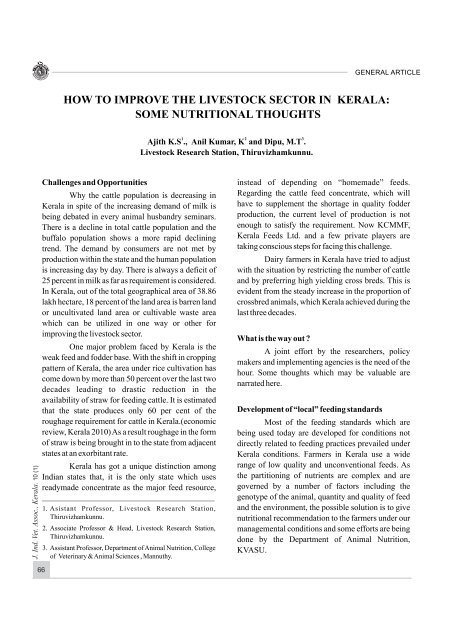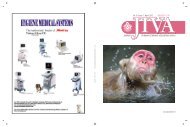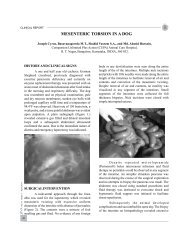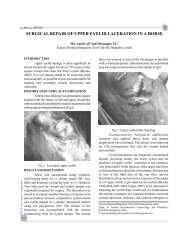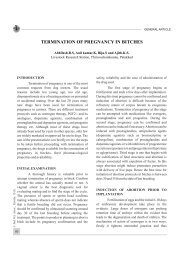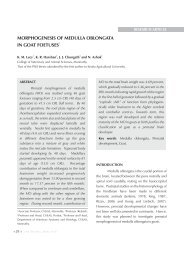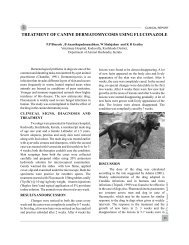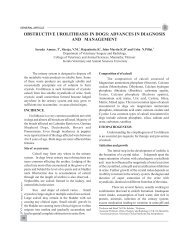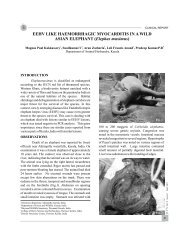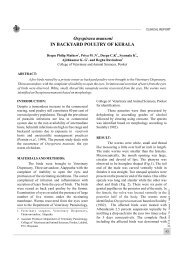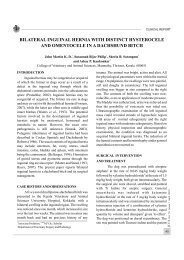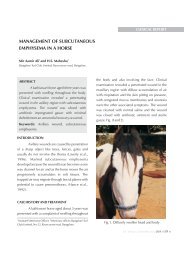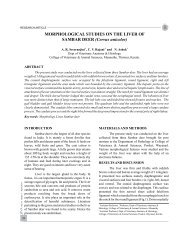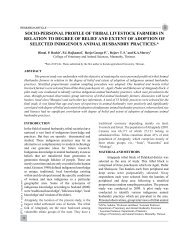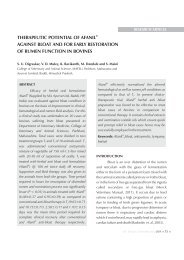how to improve the livestock sector in kerala: some ... - Jivaonline.net
how to improve the livestock sector in kerala: some ... - Jivaonline.net
how to improve the livestock sector in kerala: some ... - Jivaonline.net
Create successful ePaper yourself
Turn your PDF publications into a flip-book with our unique Google optimized e-Paper software.
GENERAL ARTICLE<br />
HOW TO IMPROVE THE LIVESTOCK SECTOR IN KERALA:<br />
SOME NUTRITIONAL THOUGHTS<br />
1 2 3<br />
Ajith K.S ., Anil Kumar, K and Dipu, M.T .<br />
Lives<strong>to</strong>ck Research Station, Thiruvizhamkunnu.<br />
J. Ind. Vet. Assoc., Kerala. 10 (1)<br />
Challenges and Opportunities<br />
Why <strong>the</strong> cattle population is decreas<strong>in</strong>g <strong>in</strong><br />
Kerala <strong>in</strong> spite of <strong>the</strong> <strong>in</strong>creas<strong>in</strong>g demand of milk is<br />
be<strong>in</strong>g debated <strong>in</strong> every animal husbandry sem<strong>in</strong>ars.<br />
There is a decl<strong>in</strong>e <strong>in</strong> <strong>to</strong>tal cattle population and <strong>the</strong><br />
buffalo population s<strong>how</strong>s a more rapid decl<strong>in</strong><strong>in</strong>g<br />
trend. The demand by consumers are not met by<br />
production with<strong>in</strong> <strong>the</strong> state and <strong>the</strong> human population<br />
is <strong>in</strong>creas<strong>in</strong>g day by day. There is always a deficit of<br />
25 percent <strong>in</strong> milk as far as requirement is considered.<br />
In Kerala, out of <strong>the</strong> <strong>to</strong>tal geographical area of 38.86<br />
lakh hectare, 18 percent of <strong>the</strong> land area is barren land<br />
or uncultivated land area or cultivable waste area<br />
which can be utilized <strong>in</strong> one way or o<strong>the</strong>r for<br />
improv<strong>in</strong>g <strong>the</strong> lives<strong>to</strong>ck sec<strong>to</strong>r.<br />
One major problem faced by Kerala is <strong>the</strong><br />
weak feed and fodder base. With <strong>the</strong> shift <strong>in</strong> cropp<strong>in</strong>g<br />
pattern of Kerala, <strong>the</strong> area under rice cultivation has<br />
come down by more than 50 percent over <strong>the</strong> last two<br />
decades lead<strong>in</strong>g <strong>to</strong> drastic reduction <strong>in</strong> <strong>the</strong><br />
availability of straw for feed<strong>in</strong>g cattle. It is estimated<br />
that <strong>the</strong> state produces only 60 per cent of <strong>the</strong><br />
roughage requirement for cattle <strong>in</strong> Kerala.(economic<br />
review, Kerala 2010) As a result roughage <strong>in</strong> <strong>the</strong> form<br />
of straw is be<strong>in</strong>g brought <strong>in</strong> <strong>to</strong> <strong>the</strong> state from adjacent<br />
states at an exorbitant rate.<br />
Kerala has got a unique dist<strong>in</strong>ction among<br />
Indian states that, it is <strong>the</strong> only state which uses<br />
readymade concentrate as <strong>the</strong> major feed resource,<br />
1. Asistant Professor, Lives<strong>to</strong>ck Research Station,<br />
Thiruvizhamkunnu.<br />
2. Associate Professor & Head, Lives<strong>to</strong>ck Research Station,<br />
Thiruvizhamkunnu.<br />
3. Assistant Professor, Department of Animal Nutrition, College<br />
of Veter<strong>in</strong>ary & Animal Sciences , Mannuthy.<br />
<strong>in</strong>stead of depend<strong>in</strong>g on “homemade” feeds.<br />
Regard<strong>in</strong>g <strong>the</strong> cattle feed concentrate, which will<br />
have <strong>to</strong> supplement <strong>the</strong> shortage <strong>in</strong> quality fodder<br />
production, <strong>the</strong> current level of production is not<br />
enough <strong>to</strong> satisfy <strong>the</strong> requirement. Now KCMMF,<br />
Kerala Feeds Ltd. and a few private players are<br />
tak<strong>in</strong>g conscious steps for fac<strong>in</strong>g this challenge.<br />
Dairy farmers <strong>in</strong> Kerala have tried <strong>to</strong> adjust<br />
with <strong>the</strong> situation by restrict<strong>in</strong>g <strong>the</strong> number of cattle<br />
and by preferr<strong>in</strong>g high yield<strong>in</strong>g cross breds. This is<br />
evident from <strong>the</strong> steady <strong>in</strong>crease <strong>in</strong> <strong>the</strong> proportion of<br />
crossbred animals, which Kerala achieved dur<strong>in</strong>g <strong>the</strong><br />
last three decades.<br />
What is <strong>the</strong> way out <br />
A jo<strong>in</strong>t effort by <strong>the</strong> researchers, policy<br />
makers and implement<strong>in</strong>g agencies is <strong>the</strong> need of <strong>the</strong><br />
hour. Some thoughts which may be valuable are<br />
narrated here.<br />
Development of “local” feed<strong>in</strong>g standards<br />
Most of <strong>the</strong> feed<strong>in</strong>g standards which are<br />
be<strong>in</strong>g used <strong>to</strong>day are developed for conditions not<br />
directly related <strong>to</strong> feed<strong>in</strong>g practices prevailed under<br />
Kerala conditions. Farmers <strong>in</strong> Kerala use a wide<br />
range of low quality and unconventional feeds. As<br />
<strong>the</strong> partition<strong>in</strong>g of nutrients are complex and are<br />
governed by a number of fac<strong>to</strong>rs <strong>in</strong>clud<strong>in</strong>g <strong>the</strong><br />
genotype of <strong>the</strong> animal, quantity and quality of feed<br />
and <strong>the</strong> environment, <strong>the</strong> possible solution is <strong>to</strong> give<br />
nutritional recommendation <strong>to</strong> <strong>the</strong> farmers under our<br />
managemental conditions and <strong>some</strong> efforts are be<strong>in</strong>g<br />
done by <strong>the</strong> Department of Animal Nutrition,<br />
KVASU.<br />
66
GENERAL ARTICLE<br />
Precision Feed<strong>in</strong>g and Total Mixed Ration (TMR)<br />
concept<br />
Consider<strong>in</strong>g <strong>the</strong> cost of production <strong>in</strong>volved,<br />
farmers are very conscious of <strong>in</strong>creas<strong>in</strong>g <strong>the</strong><br />
productivity of <strong>the</strong>ir animals. Consider<strong>in</strong>g <strong>the</strong><br />
deficiency of fodder and <strong>the</strong> <strong>in</strong>creas<strong>in</strong>g price of feed<br />
<strong>in</strong>gredients, it is possible <strong>to</strong> go for precision feed<strong>in</strong>g<br />
and one such method is <strong>to</strong>tal mixed ration. Total<br />
mixed ration is a concept of deliver<strong>in</strong>g nutrients <strong>to</strong><br />
animals as a complete balanced ration. Total mixed<br />
ration consists of concentrate, roughage and<br />
micronutrients / feed additives. The concentrate and<br />
roughage are added <strong>in</strong> different levels, accord<strong>in</strong>g <strong>to</strong><br />
<strong>the</strong> stage of lactation and physiological stage of <strong>the</strong><br />
animal. Roughage part is generally crop residue or<br />
hay. The concentrate portion <strong>in</strong>cludes oilcakes,<br />
molasses, gra<strong>in</strong>s or gra<strong>in</strong> byproducts. Bypass<br />
prote<strong>in</strong>s or bypass fat can also be added depend<strong>in</strong>g on<br />
<strong>the</strong> requirement of <strong>the</strong> animal. Micro nutrients,<br />
vitam<strong>in</strong>s, trace m<strong>in</strong>erals, b<strong>in</strong>ders, probiotics,<br />
antioxidants, anti<strong>to</strong>x<strong>in</strong>s and herbal extracts are also<br />
<strong>in</strong>cluded <strong>to</strong> promote proper body function. These<br />
<strong>in</strong>gredients are made <strong>in</strong><strong>to</strong> blocks us<strong>in</strong>g hydraulic<br />
press and as a result of densification process <strong>the</strong><br />
concentrate matter get attached <strong>to</strong> <strong>the</strong> roughage along<br />
with molasses which facilitates <strong>the</strong> cellulolytic<br />
microbes <strong>to</strong> grow faster and enhance cellulolytic<br />
activity <strong>in</strong> rumen.(Walli,T.K. 2010)<br />
Advantages of Total Mixed Ration<br />
It is <strong>the</strong> best way <strong>to</strong> feed balanced ration <strong>to</strong><br />
rum<strong>in</strong>ants.<br />
Less feed wastage.<br />
Saves time and labor.<br />
Easy for transportation and s<strong>to</strong>rage.<br />
Crop residues can be effectively utilized<br />
Reduces methane production.<br />
Improved productive and reproductive<br />
efficiency.<br />
Use of Agricultural or Industrial byproducts or<br />
novel feeds<br />
Dur<strong>in</strong>g 2009-10, <strong>the</strong> price of cow milk has<br />
<strong>in</strong>creased only by 6 percent <strong>in</strong> Kerala. On <strong>the</strong> <strong>in</strong>put<br />
side, <strong>the</strong> price of grass, g<strong>in</strong>gelly oil cake, coconut oil<br />
cake and ground nut cake recorded an <strong>in</strong>crease of 20<br />
percent, 12 percent, 3 percent and 12.5 percent<br />
respectively dur<strong>in</strong>g 2009-10. The <strong>in</strong>creased cost of<br />
<strong>in</strong>puts is a serious threat affect<strong>in</strong>g profitability of<br />
dairy farm<strong>in</strong>g. S<strong>in</strong>ce feed cost accounts <strong>to</strong> about 70<br />
percent of <strong>the</strong> cost of <strong>the</strong> lives<strong>to</strong>ck farm<strong>in</strong>g, research<br />
should be focused on measures <strong>to</strong> reduce <strong>the</strong> cost of<br />
feed<strong>in</strong>g. Researches on nutritional and possible<br />
<strong>in</strong>clusion of tapioca leaves, tapioca starch waste,<br />
rubber seed, coffee husk, neem seed, coconut pith,<br />
planta<strong>in</strong> rhizome, cashew apple waste, pepper waste,<br />
African payal, palm leaves, frog meal, prawn waste,<br />
jack fruit waste, cocoa pods, etc <strong>in</strong> cattle feed had<br />
been undertaken at <strong>the</strong> Department of Animal<br />
nutrition, Kerala Veter<strong>in</strong>ary And Animal Sciences<br />
University. These results should be popularized<br />
among farmers and <strong>the</strong> farmers should be<br />
encouraged <strong>to</strong> produce of low cost feed us<strong>in</strong>g <strong>the</strong><br />
locally available feed resources at <strong>the</strong>ir door steps.<br />
Agricultural by products and crop residues which are<br />
available <strong>in</strong> plenty can be effectively utilized ei<strong>the</strong>r<br />
by physical treatment (chopp<strong>in</strong>g of straw or water<br />
soak<strong>in</strong>g), chemical treatment (Urea treatment of<br />
straw) or by biological treatment (us<strong>in</strong>g fungi or<br />
treatment with exogenous fibrolytic enzymes).<br />
S<strong>in</strong>ce <strong>the</strong>re is emergence of more and more<br />
human food <strong>in</strong>dustries, <strong>the</strong>ir byproducts can form<br />
excellent substances <strong>to</strong> be <strong>in</strong>cluded <strong>in</strong> cattle feed.<br />
Notable examples be<strong>in</strong>g brewery waste, p<strong>in</strong>e apple<br />
waste, spent g<strong>in</strong>ger, tea waste, flours of bread<br />
<strong>in</strong>dustry, etc. Much nutritional studies <strong>in</strong> this regard<br />
have <strong>to</strong> be conducted <strong>in</strong> future.<br />
Use of bypass technology<br />
Rum<strong>in</strong>ants have advantage over nonrum<strong>in</strong>ants<br />
<strong>in</strong> that <strong>the</strong>y can digest large amount of<br />
fiber and <strong>the</strong>y can utilize non prote<strong>in</strong> nitrogen.<br />
However <strong>the</strong>re are also <strong>some</strong> constra<strong>in</strong>ts as <strong>the</strong><br />
microbial nutrients may be <strong>in</strong>sufficient for a higher<br />
produc<strong>in</strong>g animal and <strong>the</strong> concept of bypass prote<strong>in</strong>,<br />
bypass fat and by pass starch comes <strong>in</strong> <strong>to</strong> picture.<br />
Steps have <strong>to</strong> be taken for educat<strong>in</strong>g <strong>the</strong> farmers for<br />
judicious use of <strong>the</strong> feed available <strong>to</strong> <strong>the</strong>m.<br />
JIVA Vol. 10 Issue 1 April 2012<br />
67
GENERAL ARTICLE<br />
J. Ind. Vet. Assoc., Kerala. 10 (1)<br />
How <strong>to</strong> <strong>in</strong>crease <strong>the</strong> fodder base Role of socially<br />
committed NGOs<br />
As stated elsewhere <strong>in</strong> this article, 18% of<br />
<strong>to</strong>tal geographic area <strong>in</strong> Kerala state lays<br />
underutilized. Self help groups and o<strong>the</strong>r<br />
unemployed youths can venture <strong>in</strong> <strong>to</strong> production of<br />
green grass, legume crops or tree fodders by adopt<strong>in</strong>g<br />
various silvi pastural systems and sell it <strong>to</strong> farmers as<br />
preserved form or fresh. The required technical know<br />
<strong>how</strong> should be provided <strong>to</strong> <strong>the</strong>m. Many such<br />
endeavors have been started <strong>in</strong> many parts of Kerala.<br />
Thrust on tree fodder.<br />
Various tree species which can be used as<br />
tree fodders <strong>in</strong>clude Mullan ka<strong>in</strong>i (Bridelia retusa),<br />
Murukku (Erythr<strong>in</strong>a <strong>in</strong>dica), Chamba (Eugenia<br />
jambosa), Kumbil (Gmel<strong>in</strong>a arborea), Aval<br />
(Holoptelia <strong>in</strong>tegrifolia), Subabul (Leucaena<br />
leucocephala), Venga (Pterocarpus marsupium),<br />
Agathi (Sesbania grandiflora), Njaval (Syzygium<br />
cum<strong>in</strong>i), Malayan chamba (Syzygium malaccense)<br />
etc. Various silvipastural and agro forestry<br />
techniques can be tried for <strong>in</strong>creas<strong>in</strong>g <strong>the</strong> fodder base<br />
as it will not only supply forage but also provide<br />
mulch, act<strong>in</strong>g as a control <strong>to</strong> soil erosion and<br />
enhanc<strong>in</strong>g soil fertility.<br />
Forage Conservation<br />
Kerala is blessed with abundant ra<strong>in</strong> fall. The<br />
forages which are produced <strong>in</strong> excess dur<strong>in</strong>g ra<strong>in</strong>y<br />
season should be preserved for use <strong>in</strong> <strong>the</strong> lean<br />
periods. Preservation can be done <strong>in</strong> <strong>the</strong> form of hay<br />
or silage and many self help groups can venture <strong>in</strong><strong>to</strong><br />
such activities.<br />
Improvement of forage quality is also as<br />
important as forage conservation and many ways <strong>to</strong><br />
<strong>improve</strong> <strong>the</strong> <strong>in</strong>ferior crop residues are well<br />
established.<br />
Residual feed<br />
Consider a case where two animals which are<br />
equal <strong>in</strong> all aspects are receiv<strong>in</strong>g same feed but one<br />
animal is yield<strong>in</strong>g more milk … <strong>the</strong> po<strong>in</strong>t here is <strong>the</strong><br />
feed efficiency and those animal which eat more is<br />
eat<strong>in</strong>g <strong>the</strong> residual feed. In o<strong>the</strong>r sense <strong>the</strong> feed eaten<br />
extra is a waste. So <strong>to</strong> reduce <strong>the</strong> wastage what are <strong>the</strong><br />
solutions Ge<strong>net</strong>ic selection of animals hav<strong>in</strong>g more<br />
feed efficiency. Vigorous cull<strong>in</strong>g policy should be<br />
<strong>in</strong>itiated <strong>in</strong> those animals used for progeny test<strong>in</strong>g <strong>to</strong><br />
elim<strong>in</strong>ate <strong>the</strong> character from <strong>the</strong> population.<br />
Feed additives<br />
Probiotics, prebiotics, enzymes (exogenous<br />
enzymes like Cellulases, Xylanases,<br />
Hemicellulases, Pen<strong>to</strong>sanases and amylases),<br />
organic acids and modifiers of rumen fermentation<br />
(ionophores) will help <strong>in</strong> improv<strong>in</strong>g <strong>the</strong> feed<br />
efficiency and reduce methane production.<br />
Intake strategies<br />
A nutritionally balanced ration is essential<br />
for an animal <strong>to</strong> perform at its optimum level. It is<br />
also necessary that animal should sufficiently<br />
consume <strong>the</strong> feed. Often <strong>the</strong> feed supplied may be<br />
imbalanced <strong>in</strong> m<strong>in</strong>erals, vitam<strong>in</strong>s and o<strong>the</strong>r nutrients.<br />
Supplementation poses two questions: what <strong>to</strong><br />
supply and <strong>how</strong> <strong>to</strong> supply Mult<strong>in</strong>utrient feed<br />
blocks is an answer <strong>to</strong> this as <strong>the</strong>y will supply<br />
required nutrients <strong>in</strong> an easy way.<br />
Some po<strong>in</strong>ts are narrated here which may<br />
<strong>in</strong>voke <strong>in</strong>terest <strong>in</strong> <strong>the</strong> m<strong>in</strong>ds of <strong>the</strong> stake holders of<br />
animal husbandry activities and hopefully generate<br />
enthusiasm for <strong>the</strong> betterment of this noble<br />
profession <strong>in</strong> Kerala.<br />
REFERENCES<br />
1. Kerala Economic review, 2010. Kerala State<br />
Plann<strong>in</strong>g Board, Thiruvananthapuram.<br />
2. Walli,T.K. 2010, Densified complete feed<br />
block technology and its role <strong>in</strong> enhanc<strong>in</strong>g<br />
rum<strong>in</strong>ant production, <strong>in</strong>clud<strong>in</strong>g buffaloes,<br />
Proceed<strong>in</strong>gs of <strong>in</strong>ternational Buffalo<br />
Conference :294-300<br />
68


